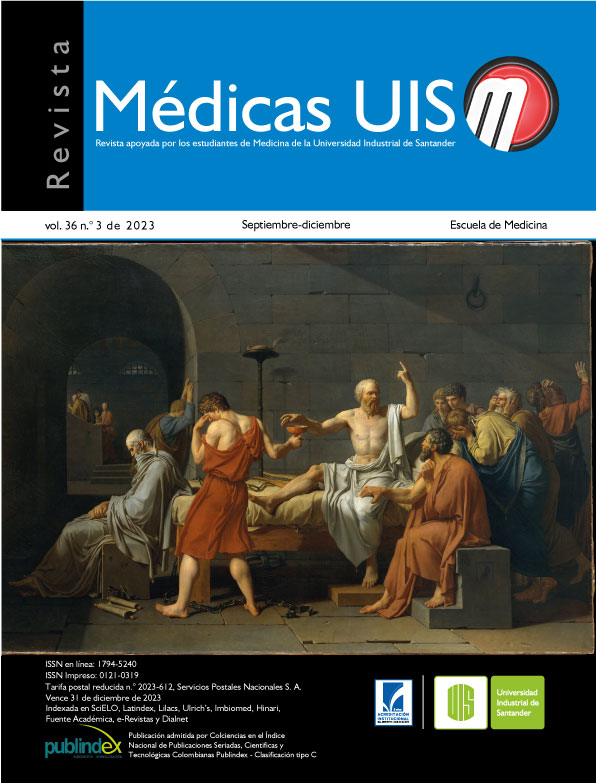Abstract
Introduction: diabetic foot is a chronic complication of diabetes that consists of infection, ulceration or destruction of the tissues of the foot, which can lead to amputation of the limb if it is not adequately controlled. Objective: characterize patients with diabetic foot and its associated complications, identifying differences related to sociodemographic, clinical and laboratory characteristics with consequent exacerbations. Materials and methods: cross-sectional descriptive observational study that included older patients with clinical diagnosis of diabetes who presented with diabetic foot between 2018 and 2020 at Clínica León XIII and Clínica Universitaria Bolivariana, Medellín, Colombia. The source of information was medical records and the data were analyzed in Microsoft Excel, where absolute and relative frequencies were calculated. Results: 39 patients with diabetic foot disease were included, 38.5% were between 61 and 70 years old, 59% were men. Type 2 diabetes was the most prevalent with 92.3%. The time between the diagnosis of diabetes and diabetic foot disease had a median of 8 years; while the time between diagnosis of diabetic foot disease and exacerbation had a median of 4.2 years. 85.7% had recurrence of exacerbations, with superficial ulceration being the most frequent with 23.8%. 57.1% of patients with exacerbations required surgery. Conclusion: Diabetic foot is present in 38.5% of patients between 61 and 70 years, this can present exacerbations up to 85.7% that increase the risk of complications and amputation. For this reason, it is important to impact and constantly assess these patients.
References
Faizan M, Sarkar A, Singh MP. Type 2 diabetes mellitus augments Parkinson's disease risk or the other way around: Facts, challenges and future possibilities. Ageing Res Rev. 2022;81:101727.
Wukich DK, Raspovic KM, Jupiter DC, Heineman N, Ahn J, Johnson MJ, et al. Amputation and infection are the greatest fears in patients with diabetes foot complications. J Diabetes Complications. 2022;36(7):108222.
Ministerio de Salud y Protección Social de Colombia [Internet]. Bogotá: Ministerio de Salud y Protección Social - Repúblicade Colombia: .En el Día Mundial de la Diabetes: MinSalud promueve prácticas de vida saludable: 2022 Nov 14. Disponible en: https://www.minsalud.gov.co/Paginas/En-el-Dia-Mundial-de-la-Diabetes-MinSalud-promueve-praticas-de-vida-saludable.aspx
Arias F, Benalcázar S, Bustamante B, Esparza J, López A, Maza G, et al. Diagnóstico y tratamiento de enfermedad vascular periférica. Revisión bibliográfica. Angiología. 2023:74(6):292-304.
Ali A, Alfajjam S, Gasana J. Diabetes Mellitus and Its Risk Factors among Migrant Workers in Kuwait. Int J Environ Res Public Health. 2022:25;19(7):3943.
Gairing SJ, Schleicher EM, Labenz C. Diabetes mellitus - risk factor and potential future target for hepatic encephalopathy in patients with liver cirrhosis?. Metab Brain Dis. 2023;38(5):1691-1700.
Li Z, Han D, Qi T, Deng J, Li L, Gao C, et al. Hemoglobin A1c in type 2 diabetes mellitus patients with preserved ejection fraction is an independent predictor of left ventricular myocardial deformation and tissue abnormalities. BMC Cardiovasc Disord. 2023;23(1):49-61.
Dayya D, O'Neill OJ, Huedo-Medina TB, Habib N, Moore J, Iyer K. Debridement of Diabetic Foot Ulcers. Adv Wound Care (New Rochelle). 2022;11(12):666-686.
Lipsky BA, Senneville E, Abbas ZG, Aragón-Sánchez J, Diggle M, Embil JM, et al. Guidelines on the diagnosis and treatment of foot infection in persons with diabetes (IWGDF 2019 update). Diabetes Metab Res Rev. 2020;36 (Suppl 1):e3280.
Zhang WQ, Tang W, Hu SQ, Fu XL, Wu H, Shen WQ, et al. C-reactive protein and diabetic foot ulcer infections: A meta-analysis. J Tissue Viability. 2022;31(3):537-543.
Rathur HM, Bouton AJ. The diabetic foot. Clin Dermatol. 2007;25(1):109-120.
Quigley M, Morton JI, Lazzarini PA, Zoungas S, Shaw JE, Magliano DJ. Trends in diabetes-related foot disease hospitalizations and amputations in Australia, 2010 to 2019. Diabetes Res Clin Pract. 2022;194:110189.
Wukich DK, Raspovic KM, Jupiter DC, Heineman N, Ahn J, Johnson MJ, et al. Amputation and infection are the greatest fears in patients with diabetes foot complications. J Diabetes Complications. 2022;36(7):108222.
Choi Y, Lee HS, Kim JW, Lee BS, Lee WJ, Jung HG. Analysis of repeated lesions after diabetic forefoot amputation. Diabetes Res Clin Pract. 2022;190.
Pintaudi B, Gironi I, Disoteo O, Meneghini E, Mion E, Massimiliano Epis O, et al.. The effectiveness of a televisit service for people with type 1 diabetes: An observational, retrospective, single center, one year follow-up study. Diabetes Res Clin Pract. 2022;189.
Andersen JC, Leong BV, Gabel JA, Murga AG, Patel ST, Abou-Zamzam AM, et al.. Conservative Management of Non-Infected Diabetic Foot Ulcers Achieves Reliable Wound Healing and Limb Salvage in the Setting of Mild-Moderate Ischemia. Ann Vasc Surg. 2022;82:81-86.

This work is licensed under a Creative Commons Attribution 4.0 International License.
Copyright (c) 2023 Médicas UIS

